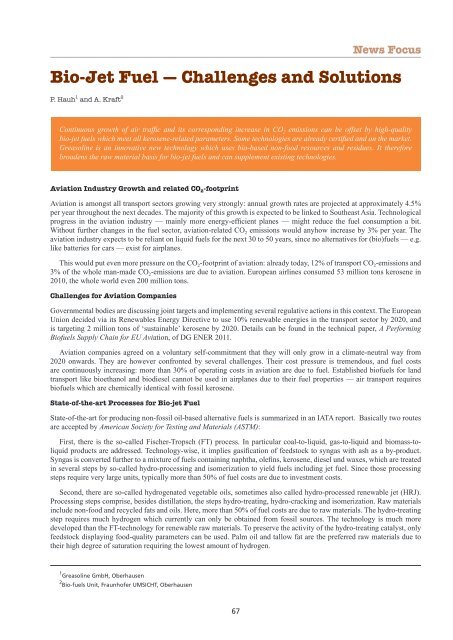Contents - Akademi Sains Malaysia
Contents - Akademi Sains Malaysia
Contents - Akademi Sains Malaysia
- No tags were found...
Create successful ePaper yourself
Turn your PDF publications into a flip-book with our unique Google optimized e-Paper software.
News FocusBio-Jet Fuel — Challenges and SolutionsP. Hauh 1 and A. Kraft 2Continuous growth of air traffic and its corresponding increase in CO 2 emissions can be offset by high-qualitybio-jet fuels which meet all kerosene-related parameters. Some technologies are already certified and on the market.Greasoline is an innovative new technology which uses bio-based non-food resources and residues. It thereforebroadens the raw material basis for bio-jet fuels and can supplement existing technologies.Aviation Industry Growth and related CO 2 -footprintAviation is amongst all transport sectors growing very strongly: annual growth rates are projected at approximately 4.5%per year throughout the next decades. The majority of this growth is expected to be linked to Southeast Asia. Technologicalprogress in the aviation industry — mainly more energy-efficient planes — might reduce the fuel consumption a bit.Without further changes in the fuel sector, aviation-related CO 2 emissions would anyhow increase by 3% per year. Theaviation industry expects to be reliant on liquid fuels for the next 30 to 50 years, since no alternatives for (bio)fuels — e.g.like batteries for cars — exist for airplanes.This would put even more pressure on the CO 2 -footprint of aviation: already today, 12% of transport CO 2 -emissions and3% of the whole man-made CO 2 -emissions are due to aviation. European airlines consumed 53 million tons kerosene in2010, the whole world even 200 million tons.Challenges for Aviation CompaniesGovernmental bodies are discussing joint targets and implementing several regulative actions in this context. The EuropeanUnion decided via its Renewables Energy Directive to use 10% renewable energies in the transport sector by 2020, andis targeting 2 million tons of ‘sustainable’ kerosene by 2020. Details can be found in the technical paper, A PerformingBiofuels Supply Chain for EU Aviation, of DG ENER 2011.Aviation companies agreed on a voluntary self-commitment that they will only grow in a climate-neutral way from2020 onwards. They are however confronted by several challenges. Their cost pressure is tremendous, and fuel costsare continuously increasing: more than 30% of operating costs in aviation are due to fuel. Established biofuels for landtransport like bioethanol and biodiesel cannot be used in airplanes due to their fuel properties — air transport requiresbiofuels which are chemically identical with fossil kerosene.State-of-the-art Processes for Bio-jet FuelState-of-the-art for producing non-fossil oil-based alternative fuels is summarized in an IATA report. Basically two routesare accepted by American Society for Testing and Materials (ASTM):First, there is the so-called Fischer-Tropsch (FT) process. In particular coal-to-liquid, gas-to-liquid and biomass-toliquidproducts are addressed. Technology-wise, it implies gasification of feedstock to syngas with ash as a by-product.Syngas is converted further to a mixture of fuels containing naphtha, olefins, kerosene, diesel und waxes, which are treatedin several steps by so-called hydro-processing and isomerization to yield fuels including jet fuel. Since those processingsteps require very large units, typically more than 50% of fuel costs are due to investment costs.Second, there are so-called hydrogenated vegetable oils, sometimes also called hydro-processed renewable jet (HRJ).Processing steps comprise, besides distillation, the steps hydro-treating, hydro-cracking and isomerization. Raw materialsinclude non-food and recycled fats and oils. Here, more than 50% of fuel costs are due to raw materials. The hydro-treatingstep requires much hydrogen which currently can only be obtained from fossil sources. The technology is much moredeveloped than the FT-technology for renewable raw materials. To preserve the activity of the hydro-treating catalyst, onlyfeedstock displaying food-quality parameters can be used. Palm oil and tallow fat are the preferred raw materials due totheir high degree of saturation requiring the lowest amount of hydrogen.1 Greasoline GmbH, Oberhausen2 Bio-fuels Unit, Fraunhofer UMSICHT, Oberhausen67
















